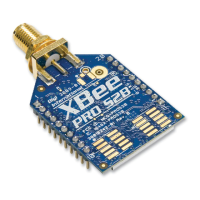Transmission, addressing, and routing Addressing
XBee/XBee-PRO ZigBee RF Modules User Guide 54
Addressing
All ZigBee devices have two different addresses, a 64-bit and a 16-bit address. The characteristics of each are
described below.
64-bit device addresses
The 64-bit address is a unique device address assigned during manufacturing. This address is unique to each
physical device. The 64-bit address includes a 3-byte Organizationally Unique Identifier (OUI) assigned by the
IEEE. The 64-bit address is also called the extended address.
16-bit device addresses
A device receives a 16-bit address when it joins a ZigBee network. For this reason, the 16-bit address is also called
the “network address”. The 16-bit address of 0x0000 is reserved for the coordinator. All other devices receive a
randomly generated address from the router or coordinator device that allows the join. The 16-bit address can
change under certain conditions:
An address conflict is detected where two devices are found to have the same 16-bit address
A device leaves the network and later joins (it can receive a different address)
All ZigBee transmissions are sent using the source and destination 16-bit addresses. The routing tables on ZigBee
devices also use 16-bit addresses to determine how to route data packets through the network. However, since
the 16-bit address is not static, it is not a reliable way to identify a device.
To solve this problem, the 64-bit destination address is often included in data transmissions to guarantee data is
delivered to the correct destination. The ZigBee stack can discover the 16-bit address, if unknown, before
transmitting data to a remote.
Application layer addressing
ZigBee devices can support multiple application profiles, cluster IDs, and endpoints. See ZigBee application
layers: in depth on page 36. Application layer addressing allows data transmissions to be addressed to specific
profile IDs, cluster IDs, and endpoints. Application layer addressing is useful if an application must
Inter-operate with other ZigBee devices outside of the Digi application profile
Use service and network management capabilities of the ZDO
Operate on a public application profile such as Home Controls or Smart Energy.
The API firmware provides a simple yet powerful interface that can easily send data to any profile ID, endpoint,
and cluster ID combination on any device in a ZigBee network.
Data transmission
ZigBee data packets can be sent as either unicast or broadcast transmissions. Unicast transmissions route data
from one source device to one destination device, whereas broadcast transmissions are sent to many or all
devices in the network.
Broadcast transmissions
Broadcast transmissions within the ZigBee protocol are intended to be propagated throughout the entire
network such that all nodes receive the transmission. To accomplish this, the coordinator and all routers that
receive a broadcast transmission will retransmit the packet three times.

